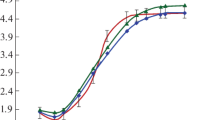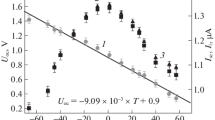Abstract
The substantiation of the lifetime stability of the emission properties of electrodes and electric characteristics of the electricity-generating channel (EGC) and element (EGE) of a space thermionic nuclear power system for an operating period of 5–10 or more years is examined. The basic reasons for the changes in the emission properties of EGE/EGC electrodes and a Topaz type reactor-converter are analyzed on the basis of test data and data from experimental simulation of the working processes in the interelectrode medium. A scheme is proposed for the working process occurring in the interelectrode medium of the EGE; the scheme is based on the Topaz materials and technology. The stability of the emission characteristics of electrodes with respect to possible changes during prolonged operation is analyzed for the most advanced designs of space nuclear power systems. The changes in time and the corresponding changes in the output electrical characteristics are estimated. 36 references.
Similar content being viewed by others
References
I. P. Stakhanov (ed.),Physical Principles of Thermionic Energy Conversion [in Russian], Atomizdat, Moscow (1973).
B. Ya. Moizhes and G. E. Pikus (eds.),Thermionic Converters and Low-Temperature Plasma [in Russian], Nauka, Moscow (1973).
B. A. Ushakov, V. D. Nikitin, and I. Ya. Emel'yanov,Principles of Thermionic Energy Conversion [in Russian], Atomizdat, Moscow (1974).
S. V. Ryabikov (ed.),Handbook of the Technology of Thermionic Converters [in Russian], Atomizdat, Moscow (1974).
V. I. Yarygin, “Electrode materials for thermionic converters of power systems of different types,”Author's Abstract of a Dissertation for Doctor of Technical Sciences, Physics and Power-Engineering Institute, Obninsk (1999).
V. A. Koryukin, I. S. Mosevitskii, V. P. Obrezumov, and B. S. Stepennov, “Emission properties of electrodes in single-element EGC over the operating lifetime,” in:Abstracts of Reports at a Departmental Anniversary Conference on Nuclear Power in Space, Physics and Power-Engineering Institute, Obninsk (1990), Part 1, p. 80.
V. A. Koryukin and V. P. Obrezumov, “Effect of the adsorption of oxygen and carbon monoxide on the emission characteristics of EGC electrodes,”ibid.,Abstracts of Reports at a Departmental Anniversary Conference on Nuclear Power in Space, Physics and Power-Engineering Institute, Obninsk (1990), Part 1, p. 100.
V. I. Yarygin, A. V. Vizgalov, M. V. Gulin, and V. S. Mironov, “Thermionic converter with W(110)—W(110) monohedral electrodes,”ibid.,Abstracts of Reports at a Departmental Anniversary Conference on Nuclear Power in Space, Physics and Power-Engineering Institute, Obninsk (1990), Part 1, pp. 84–85.
V. I. Yarygin, V. R. Agafonov, D. V. Dodonov, et al., “Behavior of carbon on the (110) and (112) faces of a tungsten single crystal in simulating the interaction with an electrode medium of a thermionic converter,” in:24th International Conference on Engineering Problems of Energy Conversion (IECC), Washington, USA (1989), Vol. 2, pp. 1155–1160.
V. R. Agafonov and V. I. Yarygin, “Characteristics of electrodes of thermionic converters in model experiments with surface monitoring,” in:Abstracts of Reports at the Conference on Nuclear Power in Space, Physics and Power-Engineering Institute, Obninsk, Part 1, p. 98–99.
V. R. Agafonov and V. I. Yarygin, “Study of the properties of the emitter of a thermionic converter in model experiments with surface monitoring,” in:25th International Conference on Engineering Problems of Energy Conversion (IECEC), Reno, USA (1990), Vol. 2, pp. 322–325.
V. R. Agafanov and V. I. Yarygin, “Investigation of the properties of the collector of a thermionic converter in model experiments with surface monitoring,” in:26th International Conference on Engineering Problems of Energy Conversion (IECEC), Boston, USA (1991), Vol. 2, pp. 285–290.
V. R. Agafonov, A. V. Vizgalov, and V. I. Yarygin, “Comparative analysis of the emission-adsorption characteristics of the VN-2 and W(110) collectors of thermionic converters in model experiments with surface monitoring,” in:Abstracts of Reports at the 2nd Departmental Conference on Nuclear Power in Space, Physics of Thermionic Energy Converters, Sukhumi (1991), Part. 1, p. 53.
R. V. Savvov, Z. B. Skrebova, V. I. Yarygin, and N. N. Khramushin, “Lifetime change of the characteristics of the collector surfaces in thermionic converters,” in:Abstracts of Reports at the Departmental Anniversary Conference on Nuclear Power in Space, Obninsk (1990), Part 1, pp. 75–76.
G. V. Samsonov (ed.),Handbook of Physical—Chemical Properties of Oxides [in Russian], Metallurgiya, Moscow (1978).
A. S. Gontar', D. Yu. Lyubimov, and A. S. Panov, “Analysis of mass transfer processes in the interelectrode gap of EGC,” in:Abstracts of Reports at the 5th International Conference on Nuclear Power in Space, Podol'sk, March 1999, p. 44.
A. V. Bushinskii, N. I. Ezhov, G. A. Zaritskii, et al., “Vapor generator for the cesium recovery system of thermionic converter reactor,”ibid.,Abstracts of Reports at the 5th International Conference on Nuclear Power in Space, Podol'sk, March 1999, p. 96.
M. Roberts and C. Mackey,Chemistry of Metal-Gas Interfaces [Russian translation], Mir, Moscow (1981), p. 540.
H. Henrici-Olive and S. Olive,Chemistry of Catalytic Hydration of CO [Russian translation], Mir, Moscow (1987).
N. Udovic, R. Kelley, and T. Madey,Surf. Sci.,150, L71-L76 (1985).
V. A. Kuznetsov, “Thermionic reactors,” in:Proceedings of the 3rd International Conference on Thermionic Electric Power Generators, Juelich, FRG (1972), Vol. 1, pp. 365–380; G. M. Gryaznov, A. I. El'tsov, V. A. Kuznetsov, et al., “Power tests of the Topaz-3 thermionic reactor,” in:Proceedings of the 1975 Thermionic Conversion Special Meeting, Eindboven, The Netherlands (1975).
N. N. Ponomarev-Stepnor, “Nuclear power in space,”At. Énerg.,66, No. 6, 371–374 (1989).
E. Fromm and E. Gebhardt,Gases and Carbon in Metals [Russian translation], Metallurgiya, Moscow (1980).
N. G. Primakov, V. A. Rudenko, V. V. Kazarnikov, and M. K. Ovcharenko, “Mass transfer in the constructional materials under the operating conditions of thermionic converter reactors,”Preprint FÉI-2717 (1998).
P. V. Andreev, A. G. Eremin, E. E. Zhabotinskii, et al., “Basic tenets of the concept of second-generation thermionic space nuclear power systems based a thermoelectric material taking account of the possibilities of modern means for launching into orbit,” in:Abstracts of Reports at the 5th International Conference on Nuclear Power in Space, Podol'sk, March 1999, p. 8.
Yu. G. Degal'tsev, N. N. Pnomarev-Stepnoi, and V. F. Kuznetsov,Behavior of a High-Temperature Nuclear Fuel under Irradiation [in Russian], Énergoatomizdat, Moscow (1987).
R. B. Kotel'nikov, S. N. Bashlykov, A. I. Kashtanov, and T. S. Men'shikova,High-Temperature Nuclear Fuel [in Russian], Atomiadat, Moscow (1969).
N. N. Ponomarev-Stepnoi and A. A. Khrulev, “Leakage of fission products from high-temperature fuel materials,” in:International Conference on Thermionic Energy Conversion, Juelich, Germany, June 1972, Vol. 2, pp. 963–978.
V. A. Usov, V. D. Fomenko, and A. A. Khrulev, “Contribution to the question of the lifetime of objects used in space with a nuclear-power system,” in:Abstracts of Reports at the Departmental Anniversary Conference on Nuclear Power in Space, Physics and Power-Engineering Institute, Obninsk (1990), Part 1, pp. 288–289.
V. G. Asmolov, “Results of investigations of serious accidents involving water-cooled reactors,At. Énerg.,76, No. 4, 282–302 (1994).
M. V. Chernetsov, A. V. Kozlov, and L. A. Skryabin, “Results of electron-microscopic investigations and elemental analysis of the surfaces of ventilated high-temperature fuel element after reactor tests,” in:Abstracts of Reports at the 5th International Conference on Nuclear Power in Space, Podol'sk, March 1999, p. 51.
V. P. Semenov, V. V. Sinyavskii, and V. D. Yuditskii, “Space two-mode nuclear power system for propulsion of communication satellites into a geostationary orbit and prolonged (up to 15 yr) powering of the apparatus,” in:Calculation, Design. Construction, and Testing of Space Systems. Part 3 “Space Thermionic Nuclear Power Systems and High-Power Electrorocket Motors,” RKK “Énergiya” im. S. P. Koroleva (1998), pp. 8–20.
Yu. V. Nikolaev, A. S. Gontar', N. V. Lapochkin, et al., “Multielement electricity generating channel for a nuclear power-propulsion system,” in:Abstracts of Reports at the International Seminar on Space Power Engineering of the 21st Century “Nuclear Aspect,” Obninsk. Podol'sk, November 1998, p. 70.
V. I. Chitaikin, M. K. Ovcharenko, V. I. Ionkin, et al., “Combined nuclear-power system TÉMBR with a reactor-converter operating on fast neutrons,” in:Abstracts of Reports at the 5th International Conference on Nuclear Power in Space, Podol'sk, March 1999, p. 51.
V. I. Yarygin, V. I. Ionkin, G.A. Kuptsov, et al., “New-generation space thermionic nuclear power systems with the electricity-generating systems placed outside the reactor core,” in:Abstracts of Reports at the 2nd International Conference on Space Nuclear Power Engineering of the 21st Century (April 19–21, 2000), Obninsk (2000), p. 17.
D. V. Yarygin, V. S. Mironov, N. P. Solov'ev, et al., “Thermionic converter with high output electric characteristics with a Me−O system on the collector,”ibid.,Abstracts of Reports at the 2nd International Conference on Space Nuclear Power Engineering of the 21st Century (April 19–21, 2000), Obninsk (2000), p. 71.
Additional information
State Science Center of the Russian Federation—A. I. Leipunskii Physics and Power-Engineering Institute. Translated from Atomnaya Énergiya, Vol. 89, No. 1, pp. 57–67, July, 2000.
Rights and permissions
About this article
Cite this article
Agafonov, V.R., Yarygin, V.I. Lifetime changes in the characteristics of thermionic converters. At Energy 89, 565–573 (2000). https://doi.org/10.1007/BF02673516
Issue Date:
DOI: https://doi.org/10.1007/BF02673516




